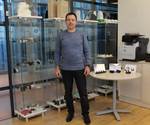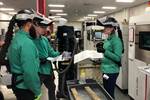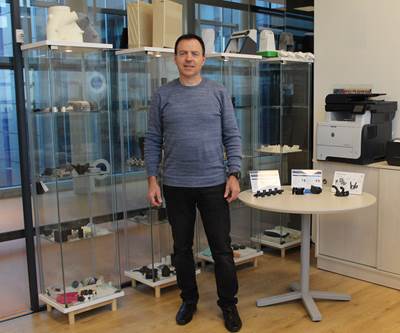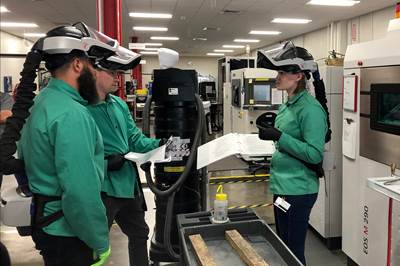Workforce development efforts tend to focus on recruiting the next generation of employees. But what about those who are already in the manufacturing industry and want to pivot to additive manufacturing? And how should companies think about developing their current workforce to make implementing additive a success? In this episode of the AM Radio podcast, I talk with digital associate editor Jodee McElfresh about pursuing additive both as an individual and at the organizational level.
Transcript
Stephanie Hendrixson 16:18
All right, welcome back. I'm Stephanie Hendrixson talking with Jodee McElfresh, about things from social media, topics inspired by social media. So in the second half of the show, we're going to change gears here a little bit. Jodee, what have you been seeing on social media lately? And what's something that you want to talk about?
Jodee McElfresh 16:43
Something I've seen recently that I think pretty much anybody that follows manufacturing online has seen is that October was Manufacturing Month, it's a month dedicated to getting the next generation interested in manufacturing, as a career path, not just a hobby, there were lots of posts touting the benefits of a career in manufacturing and things for young people to consider.
Stephanie Hendrixson 17:08
So yeah, absolutely. I saw tons of those posts, Manufacturing Day is during October, as well. So we see lots of people hosting tours, welcoming people in the community into their facilities. And just there's just a lot of buzz about manufacturing careers during this month.
Jodee McElfresh 17:22
Yeah. And a lot of those posts, though, understandably, are geared towards the next generation young people, people who maybe are still in high school. But something I've been wondering is, what if you're already in the world of manufacturing, or maybe not even in manufacturing, and you want to switch to AM? So not that you're a company wanting to adopt it, but you're an individual who wants to retool and move from, say, a job where you're doing injection molding, and you want to move to AM, it's not really a lateral move, or maybe it is, but does 15 years of experience in X manufacturing industry provide enough of a basis to move to AM and I recognize, too, that there's overlap between industries. So maybe it's that your current job and manufacturing integrates AM and you just have to adjust? So how do you make that adjustment? How do you make that move? What do people who aren't high schoolers thinking about their their future…what do they do?
Stephanie Hendrixson 18:25
Yeah, that's a great question. Because I mean, there are these training programs, and you know, degrees and things in additive manufacturing. In fact, we've got a whole how to get a job in additive manufacturing resource on our website that deals with this and has all these things listed out. But those classes and those degree programs are relatively new. So a lot of times when I'm like visiting facilities and meeting people who are doing interesting things with additive, they don't have those credentials, just because it hasn't been around that long. And so exactly, as you say, like they've made some sort of lateral move into additive manufacturing, whether it's from an injection molding background, a machining background, or some other place within manufacturing or outside of it.
Jodee McElfresh 19:09
Do you have specific examples of places that you've been where you have seen this?
Stephanie Hendrixson 19:14
Yeah, so like, the one that comes right to mind is this company that I visited, I think last year, it's called Iten Industries. It's a manufacturer up in Northeast Ohio, company's 100 years old. They make laminates, they make composites, they do plastic injection molding, they make their own molds there. They have like lots of different manufacturing capacity. But they've recently gotten into 3D printing. And sort of the way that it happened was the leadership of the company saw the need and saw the opportunity in it. They also saw that they had an employee who was sort of up to speed on 3D printing already. So his name is Devin Curtis. And Devin was working at Iten as a quality engineer, so he was doing like inspections and stuff like that. But in his free time he had this desktop 3D printer, and he was just sort of playing with it on his own time making making stuff for his own hobbies and that sort of thing. But he started to see these opportunities at his job where it would be really, really useful to be able to make a prototype of a part before you spend all the time cutting the injection mold and tooling up for that process. And so he started printing prototypes for work on his own printer. Eventually, that printer went into the office with him. And now Iten is really, really leaning into this idea. So they've got this newly renovated part of their facility that they call the Imagineering Center, and you walk in, and they've got a couple of printers from Jack-O-Bot, that are sort of like medium sized, or pretty large printers, there're, you know, maybe the size of like a small car or something, they're pretty big. And so they've got a couple of those printers that they're using for prototypes for tooling, actually, some end use products, now they're sort of moving towards that. And then kind of back in the corner, Devin’s printer is still there. So they're still using that. And so that's a case where there was an employee there who was willing to pick up this, this new type of technology, willing to learn about it. And now like he's running the additive manufacturing department at this company, because he was there and already building that expertise. And I feel like I see that sort of transition happen a lot, where it's just somebody has an interest, they've put the time in to start to get familiar with it on their own. And some leadership at the company recognizes that and lets that person sort of take that and run with it.
Jodee McElfresh 21:34
That is really cool. It's one person making a huge impact on a company's operations. And it's, it sounds like, it's not just that one individual, it's also the leadership, they're kind of keeping their ear to the ground, and just being open to making that change.
Stephanie Hendrixson 21:51
Yeah, and I think that's really, really key, like if it was Devin by himself, or if it was somebody kind of in his shoes that's interested in 3D printing and sees possibilities with it. Unless you have the ear of the CEO or the business owner, it's going to be really hard to make those changes, though. So I've also seen on the flip side, you know, people who have been put in charge of implementing additive manufacturing inside of a larger organization, and they don't have the resources, or they don't have the support that they need to really make a difference. If you think about how additive manufacturing has the most impact, it's when it comes in at the design phase, or even earlier than that, it's when you can talk about things like how are you going to fulfill your orders? And how are you going to maintain your inventory? And can we get these two different parts to be 3D printed into one and like consolidate this assembly, like you really need that sort of overall perspective and support from the leadership in order to make that work. So for people like Devin who want to make that change, I mean, I would really encourage you to learn what you can on your own and sort of make it known that you have that interest in that knowledge. But also be aware that without leadership from the top, it's going to be really difficult to make a meaningful change in a big organization if it's just one person trying to do it.
Jodee McElfresh 23:09
Sounds like Devin could maybe do some consulting on the side. Okay, so maybe there are some leaders at some companies that, whose ears are perking up at this conversation, if they've made it this far.
Stephanie Hendrixson
I hope so.
Jodee McElfresh
And, you know, maybe they're thinking, Okay, tell me what I need to be considering then. I'm open. But what do I need to be looking for specifically, what do I need to know?
Stephanie Hendrixson 23:35
The two main approaches that I see companies taking are either to try and distribute their 3D printing capacity like all over the place, and try to spread the knowledge that way. And so one example that comes to mind is Flex. So they are a large contract manufacturer, they make consumer products, they make electronics and make all different types of industrial components. And they've got these 3D printing centers in a bunch of their different production facilities. I think there are maybe four or five of them. And so each one of these is co-located at a Flex facility, it has its own staff. And the facilities are being used to print prototypes to print tooling to print end use parts. And, you know, their thought was by distributing the 3D printing capacity and the 3D printing knowledge and trying to grow it in these different places. We will get further along if more people know about it, and we're and we're doing it in more locations. The challenge with that, though, is that different facilities are going to advance at different rates. They're going to be making different things. They're going to be learning different lessons, and are you able to sort of like capture all of that disparate knowledge and use it to advance together as an organization. On the flip side, I've seen a lot of companies that decide to centralize their additive manufacturing capacity figuring, you know, if we just throw all of our resources into this one facility and this one One group of people, and this one set of equipment, we're going to learn a lot faster. And then you know, maybe some somewhere down the road, we're going to be able to disperse that knowledge, I think it really does need to start with sort of an overall look at your organization and what you hope to accomplish from 3D printing, if you really just want to be able to make spare parts on demand and like build a digital inventory, that's going to be a different strategy than like a startup that is trying to bring a product to market and they think 3D printing is going to be the way to go. But I think what it comes down to is supporting the people that are being put in charge of making this change happen, giving them the resources that they need, and letting them know that the organization is bought into what they're trying to do. Because without that, nothing's gonna happen.
Jodee McElfresh 25:48
Are there any other considerations for leaders at a company that aren't higher level, you know, what is just kind of the tactical, common-sense considerations that are out there for changing over your company and individuals in your employees who aren’t AM-focused now, but you are hoping to be in the future?
Stephanie Hendrixson 26:13
Yes. So I mean, aside from the technical aspects, like you're going to need equipment, you're going to need a space to do this work, you're going to need connection to other parts of the business, right. But you're also going to need employees and like some of the employees you have right now might be, you know, the next Devin, and they might be somebody who can pivot into that sort of role. This is interesting, because I actually I just visited the Siemens CATCH facility, which is down in Charlotte, North Carolina, CATCH stands for Charlotte Advanced Technology Collaboration Hub. And it's this facility that kind of exists inside of a Siemens factory for like these huge gas turbines. But what they're doing there is working with industry partners, and government agencies and all types of collaborators to solve manufacturing problems. And so they're doing everything from optimizing heat exchangers, to developing wearable technology with like 3D printed circuits, and all that sort of thing. But one of the projects that I learned about there was this initiative, where one of the Siemens employees created a personality test to determine whether someone has an appetite for new technologies. And this was partly funded, I believe, through the AM Forward project. And the idea was, we can use this personality tests, we can give it to our current employees, to figure out who has the right mindset to do additive manufacturing, like who is going to be open to this technology and be able to think in the sort of way that you need to, in order to make this a success. So I think that the personality aspect of this is at least as important as the technology aspect, at least as important, as you know, the kind of funding and facilities and hardware software that you're able to get access to, if you don't have the right mindset, it's not very likely that your additive manufacturing efforts are going to succeed.
Jodee McElfresh 28:05
So you know, when I asked, when I mentioned manufacturing month, and what I've been seeing on social media about it, and I said that there were a lot of posts addressing the next generation. And then I asked how does this impact people or, you know, current manufacturing staff, I think it's important to not just think about this as a generational thing. But these are real people, real individuals. When we talk about labor shortages, which is another big thing I see across social media, I think we all do, there's not just a group of people who aren't working, or it's not just this generation, this next generation, it's individuals, and we're talking about individuals, we're kind of wanting individuals to think about their place at their company, how they can see themselves working in AM, because its AM is coming into manufacturing, whether you want it to or not, how much it might impact your company, your industry, I guess that all depends, but it has made inroads and I'm not saying that it's taking over, but it's being integrated.
Stephanie Hendrixson 29:13
Yeah, it's definitely making inroads. It's not taking over, it may never take over. But I think it's it's an important aspect of the way manufacturing works now. And ignoring it is probably not a great strategy. Figuring out how to work with it probably is the thing that most manufacturers need to do. And so whether that is doing something right now today with the people and the resources that you have, and trying to figure it out, or waiting for the next generation, I would say you probably don't want to wait too long.
Jodee McElfresh 29:46
How many times have we heard that it's easier to retain a client or even retain, it's always easier to retain than it is to recruit new, it seems like in a variety of fields, so whether that, it's a client and employee. And there are manufacturers out there who already have employees. And there's also a labor shortage that we're experiencing. So how do you reconcile that by, you know, boosting up your current employees, and looking ahead at what they can do and basically just not overlooking who's already on staff and bring them along with you as your company evolves.
Stephanie Hendrixson 30:26
And I think the big thing that we're talking about here is that additive manufacturing changes the entire organization, right? So it's not just going to affect, you know, Joe, over there who has been put in charge of the 3D printer. Ideally, it's going to affect Joe and all of his co-workers, it's going to affect the company owner, it's going to affect the the executives and the way that they think about pricing and shipping and how they order parts. It's going to affect the engineering department, how they're designing parts, it's going to affect the operators on the floor, who have new equipment to learn new processes to put in place. So yeah, I think the best use of 3D printing is absolutely not in isolation. And using the resources and using the people that you already have is going to be really important. All right. So I think we'll leave it there for today. Jodee, one last thing I was thinking we could do is just like a rapid fire round up of cool things on social media this week. Do you have anything?
Jodee McElfresh 31:25
Yes, I do have a couple of things. And I think I'm just going to spout these off, interesting headlines that I've seen, interesting posts that I've seen on our social media platforms. One, I saw a really cool post by somebody sharing a paper. And it's about additive manufacturing of micro architected metals via hydrogel fusion. And what I took away from this was that you can choose the material after you've printed.
Stephanie Hendrixson 31:54
Okay, that's pretty crazy. Is this something? Is this research? Or is this something that's out there being used already?
Jodee McElfresh 32:02
I think it's research. So maybe a couple years from now, we'll be able to report on it in use.
Stephanie Hendrixson 32:08
Okay, I'm intrigued, I'm gonna go look this up afterwards,
Jodee McElfresh 32:11
Definitely, I'll send you the link. Second thing I came across, 3D printed mice.
Stephanie Hendrixson 32:17
Like animal mice, or like computer mice?
Jodee McElfresh 32:20
Computer mice, these are, these are computer mice for gaming, specifically, they’re custom mice with eSport athletes in mind. I went down a rabbit hole reading about these. Gaming is such a massive industry and eSports has very serious professional contenders competitors. My takeaway from this is that using one of these custom mice, which might be more expensive than a mass produced one is pretty much in the eSport world comparable to like an MLB player moving up from his knothole glove to I don't know, whatever they use now, at the pro level.
Stephanie Hendrixson 33:00
I could see that. So actually, as a as a person, I have like very, very minor carpal tunnel. And I have like a special mouse for that. I actually, this sort of appeals to me, I might look into this.
Jodee McElfresh 33:11
Who knows maybe we'll see you one day competing in eSports, Steph.
Stephanie Hendrixson 33:15
Doubtful.
Jodee McElfresh 33:18
So third and final thing, and you know, this one's coming. 3D printed meat.
Stephanie Hendrixson 33:25
I have lots of opinions on this. I don't know if I want to get into it now. It's an interesting concept. Personally, I think it's not for me, but we don't have to get into the details at this moment.
Jodee McElfresh 33:36
Yeah, I don't think I'm ready to try it yet either. But I did like reading about it. Those are kind of the hot topics from social media right now.
Stephanie Hendrixson 33:47
All right, we'll drop links to all of those in the show description. And I look forward to chatting about what's cool on social media with you again some other time, hopefully not 3D printed meat.
Jodee McElfresh 33:59
I'm just hoping by the time we talk next that there's a 3D printed dessert. That's the one I really care about.
Stephanie Hendrixson 34:04
There is 3D printed chocolate. There's somebody that makes a chocolate printer.
Jodee McElfresh 34:08
I think we need to do a site visit.
Stephanie Hendrixson 34:10
Yeah. Sounds like a good idea. Cool. All right. Jodee. Thanks for joining me on the podcast. How can listeners find us on social media?
Jodee McElfresh 34:18
Listeners can find us on social media. We're on Twitter, LinkedIn, Instagram, Facebook, YouTube, we are Additive Manufacturing Media. Our handle on most of these platforms is @addmfgmedia.
Stephanie Hendrixson 34:34
So you know where to find us. Hope you've enjoyed listening to the AM Radio podcast. If you like the show, please consider subscribing, leave us a rating or sharing us with a friend or colleague, anybody who might be interested in additive manufacturing. Thanks for listening.
AM Radio is recorded with help from Austin Grogan. The show is edited by Jodee McElfresh and me, Stephanie Hendrixson. Our artwork is by Kate Bilbery AM Radio and Additive Manufacturing Media are products of Gardner Business Media located in the Queen City Cincinnati, Ohio I'm Stephanie Hendrixson thanks for listening.
Related Content
DMG MORI, Illinois Tech to Establish National Center for Advanced Manufacturing in Chicago
The center will focus on workforce training for additive manufacturing and related advanced manufacturing industries.
Read MoreFree AMJobs Digital Tool Supports Additive Manufacturing Education, Workforce Development
America Makes’ AMJobs is a free digital tool that facilitates access to careers, supports industry growth and talent development in the additive manufacturing industry.
Read MoreAddUp Receives ASTM Additive Manufacturing Safety Certification
AddUp Inc. announces that it has received the ASTM Additive Manufacturing Safety (AMS) Certification, becoming the first OEM in the AM industry to achieve this significant milestone.
Read MoreThink Tank, US Navy Announce Plans for Developing Guam Additive Materials and Manufacturing Accelerator
Nonprofit organization ASTRO America will manage staging and deployment of 3D Printing Technology and Workforce Education Center on Guam to diversify the island’s economy and support Indo-Pacific submarine industrial base needs.
Read MoreRead Next
How to Implement Additive Manufacturing Across a Global Company: 5 Lessons
With more than 100 facilities and about 200,000 employees worldwide, Flex has a steep challenge in bringing 3D printing into its operations. Five things the company is learning.
Read MoreHow to Pursue a Career in Additive Manufacturing
AM professionals are in demand as 3D printing matures and advances. But what skills are hiring manufacturers looking for? How can applicants prepare? And where can you find relevant job listings?
Read MoreWhat Your CEO Needs to Know About Additive Manufacturing
Additive manufacturing promises to affect far more than manufacturing alone. When evaluating AM, the perspective needed is the view that sees the impacts all across the enterprise.
Read More

.jpg;width=70;height=70;mode=crop)



















